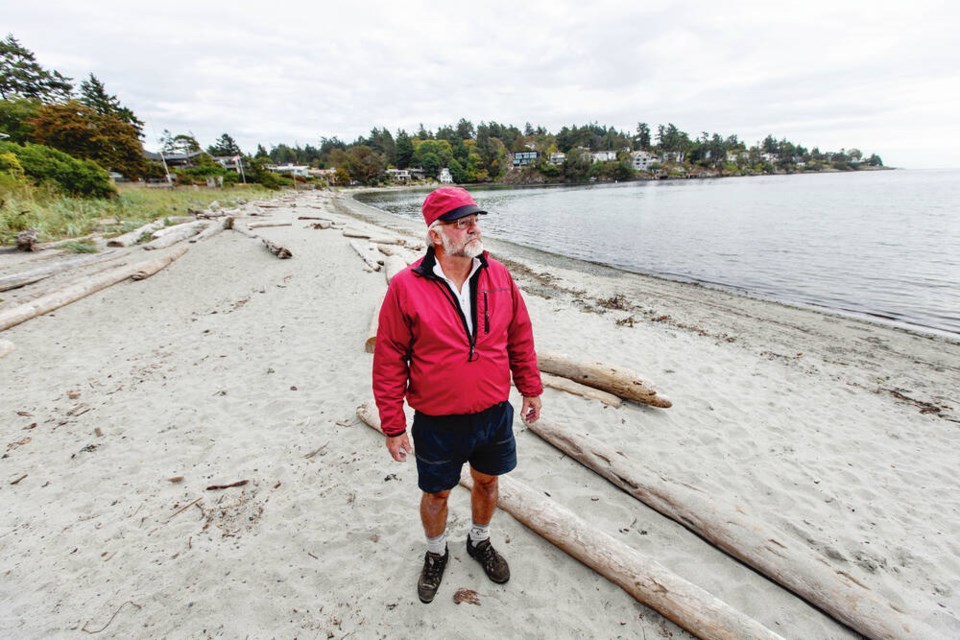Dogs have been able to play off-leash on many in Greater Victoria beaches for years, but that may soon come to an end if the federal government begins enforcing regulations protecting migratory birds along the coast.
Environment and Climate Change Canada is cracking down on unleashed dogs within the Victoria Harbour Migratory Bird Sanctuary, which includes land and water below the high-tide line from Macaulay Point in Esquimalt to Saanich’s Cadboro Bay, and up the Gorge Waterway to Portage Inlet.
The federal department says the move comes after numerous complaints to the Canadian Wildlife Service, a branch of Environment Canada, about altercations between dogs and birds in the area, which is home to Pacific great blue herons, black oystercatchers, glaucous-winged gulls and several bird species at risk.
Federal regulations governing the sanctuary prohibit owners from letting their dogs and cats run “at large” in order to protect the birds, which means dogs have to be leashed while below the high-tide line on all beaches from Macaulay Point to Cadboro Bay.
While a spokesperson for Environment Canada said wildlife enforcement officers regularly patrol migratory bird sanctuaries to ensure compliance, Jacques Sirois, chair of the Friends of Victoria Harbour Migratory Bird Sanctuary, said rules have essentially never been enforced. Unleashed dogs didn’t appear to be a significant problem until a few years ago, he said.
“We’re living in a totally different world, with a large number of pets in the bird sanctuary daily. The retreat of nature is a serious matter now. The collapse of biodiversity and declines in bird populations are now emerging as serious concerns,” he said.
Established in 1923 to control the hunting of birds, the sanctuary spans 1,841 hectares along the shores of Victoria, Oak Bay, Esquimalt, Saanich and View Royal and is an important roosting and overwintering site for many migratory bird species, says Environment Canada. Low numbers of birds remain a concern, they say.
Sirois said in the last few years, a group of people concerned about dogs and declining bird populations in the Cadboro Bay area started to lodge complaints to the federal government, including photos and videos of altercations, most commonly dogs chasing herons.
Cadboro Bay “was kind of the firestarter of sorts,” but similar issues have been noted at Willows Beach, Gonzales Beach and Clover Point, Sirois said.
Sirois said a common argument made by dog owners against leashing their pets is that they never see any birds on the beaches where they walk their dogs, so they wonder why it’s an issue.
The absence of birds is exactly the point, he said.
“If you look at our beaches, now they are basically bird-free. And that’s not normal,” he said. “The oystercatchers, the sandpipers, the plovers, the gulls should be essentially everywhere.”
Dogs running free are at least partially to blame for their absence, he said. The birds normally feed on beaches in the intertidal areas at low tide, but the presence of dogs scares them away from these foraging sites, Sirois said.
Surveys of coastal water birds in B.C. show a decline in population of about 60 to 70 per cent since 1990, he said.
“If you really want nature in the city, if you want to live with nature around you … you cannot have loose dogs everywhere. We have to have serious designated areas as dog parks,” he said.
The federal government is studying the impacts of dogs on migratory birds in the Victoria Harbour sanctuary, as well as Esquimalt Lagoon and Shoal Harbour migratory bird sanctuaries, where the same ban on off-leash dogs applies. The findings are expected to be released in a report next year.
Sirois is hoping that report comes with enforcement of the ban on unleashed dogs.



